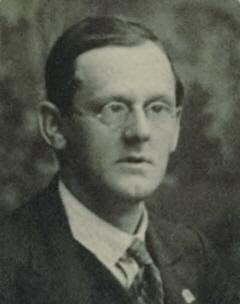
Edward Winter

F.D. Yates (C.N. 5459)
‘It made me very sad to learn, some time during the last war, that Yates had committed suicide, apparently for financial reasons. He had probably been too modest to ask British chessplayers for help.’
That comes from page 338 of Chess Secrets I Learned from the Masters by Edward Lasker (New York, 1951), a book which has helped spread a number of myths. Even at first glance, the passage above fails to impress, with its ‘apparently’ and ‘probably’ and, above all, its curious reference to ‘during the last war’ (given that Yates died in 1932).
As reported in C.N. 780 (see pages 118-119 of Chess Explorations) when ‘Assiac’ (Heinrich Fraenkel) repeated the suggestion that Yates had killed himself page 24 of the January 1963 BCM had an implacable rebuttal by that exceptional writer D.J. Morgan:

Another author who wrote forcefully on the subject was William Winter, in his posthumous memoirs on page 148 of CHESS, 23 February 1963:
‘An exhaustive enquiry was held by one of the most experienced coroners in London, and it was conclusively proved that death was due to a faulty gas fitting. Wynne-Williams, Yates’ pupil whom he had been teaching on the very night of his death, gave evidence of his cheerful demeanour, and the coroner went out of his way to state categorically that this was a case of a tragic accidental death. In spite of all this some of the vile calumniators I have mentioned before, who are always seeking for slime to throw at their betters, sank so low as to suggest that Yates committed suicide. I have even heard the report quite recently. No fouler lie could possibly be invented to smirch the memory of a courageous and noble man.’
Yates died at the age of 48. On page 525 of the December 1932 BCM P.W. Sergeant presented the facts in a way that seemed to preclude any possibility of suicide:
‘The circumstances of his end were tragic. On the night of Tuesday, 8 November he gave a very successful exhibition at Wood Green, only dropping one half-point in 16 games. On the following night he was in the company of a chess friend until fairly late, and then went back to his room in Coram Street, Bloomsbury. He was never seen alive again. It was not until Friday morning that anxiety was felt at Coram Street as to what he might be doing; for he was in the habit of secluding himself for many hours at a stretch when busy with work. On Friday, however, when no answer could be got to knocks on the door of his room, which was locked, and a smell of gas was noticed, the door was at last broken open, and he was found dead in bed.
It came out at the inquest before the St Pancras coroner on 15 November that, though the gas-taps in the room were securely turned off, there had been an escape from what a gas company’s official described as an obsolete type of fitting attached to the meter in the room. The meter, it appears, was on the floor, and the fitting must have been accidentally dislodged. A verdict was recorded of Accidental Death; and the coroner directed that the gas-pipes from the room should remain in the custody of the court. The body was conveyed to Leeds for burial on the morning of 16 November.’
Yates’ financial circumstances had unquestionably been piteous, and a dispute about the lack of support for British chessplayers broke out in the Chess World (1 January 1933, pages 185-186; 8 March 1933, pages 275-276; 8 April 1933, pages 313-315; May-June 1933, pages 363-364). For instance, his friend W.H. Watts, the chess writer and publisher, noted that the death was ‘purely accidental’ but wrote on page 185:
‘... we were so infatuated by our own pettifogging antics over the chess board that we failed to see our Champion was starving. We could not see that poor timid Yates was literally dying in our midst, too proud to tell us so himself. The very name Yates will be for ever a shameful memory in the annals of British Chess.’
The above article appeared at ChessBase.com on 6 May 2008. See too C.N. 7175 (an article by G.H. Diggle).
Our first discussion of Yates’ demise and other alleged cases of suicide or attempted suicide was in C.N. 790. See pages 118-120 of Chess Explorations.
Is ‘Frederick Dewhurst Yates’ correct? That version of his name appeared in his obituary (by P.W. Sergeant) on pages 525-528 of the December 1932 BCM and on page 7 of Yates’ posthumous work One-Hundred-and-One of My Best Games of Chess (London, 1934), which was ‘arranged and completed’ by W. Winter and ‘edited’ by W.H. Watts. Ever since, ‘Frederick Dewhurst Yates’ has been used unquestioningly.
Leonard Barden (London) points out to us a most interesting Yorkshire Chess History webpage which states that ‘the popular rendering of his name as “Frederick Dewhurst Yates” is erroneous’ and that his name was Fred Dewhirst Yates. [Updated link.]
(7910)
The most comprehensive material about Yates’ demise that we have seen was in the Manchester Guardian.
12 November 1932, page 10:
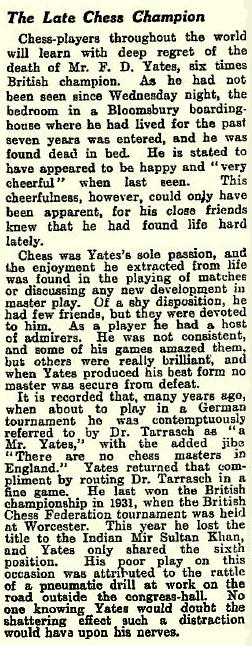
12 November 1932, page 12:
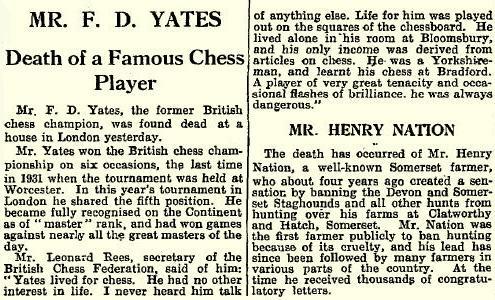
14 November 1932, page 2 (painting a very different picture of Yates’ non-chess interests, compared to Leonard Rees’ remarks above):

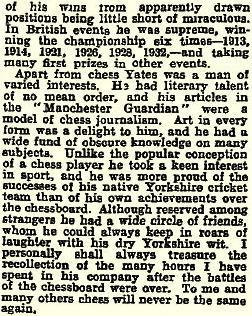
16 November 1932, page 11:
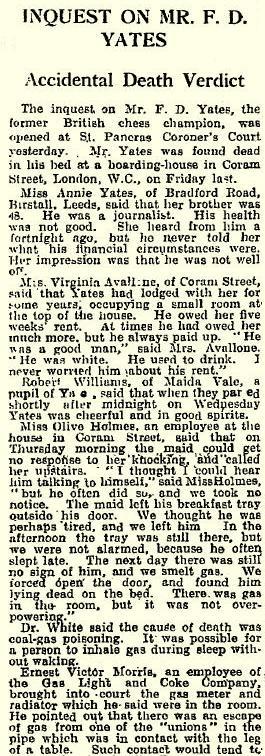
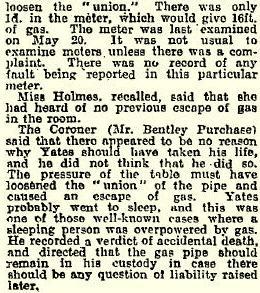
17 November 1932, page 18:
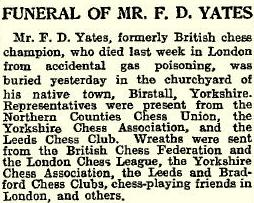
From the report in the BCM, December 1932, page 528, following the death of F.D. Yates:
‘ ... Certain chessplayers who attended the funeral agreed to make themselves responsible for the funeral expenses, but as the body was removed to Birstall in Yorkshire for burial in the family grave, the expenses were considerably heavier than was anticipated and, with the money owing to the landlady, comes to a total of about £51 2s. Od.’
C.N. 6418 noted the Oxford Dictionary of National Biography statement concerning F.D. Yates that ‘he died in debt’, and we reproduced figures regarding the ‘wealth at death’ of some other chess figures.
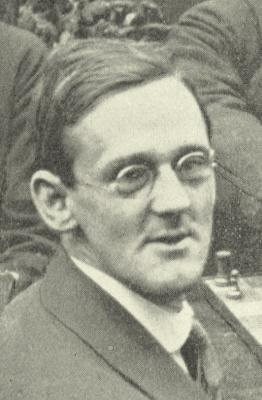
F. D. Yates
From Olimpiu G. Urcan (Singapore):
‘Having bought a digital edition of the August 2017 BCM (“Editors: Milan Dinic and Shaun Taulbut”), I saw on pages 498-499 an unsigned article “Did F.D. Yates Kill Himself?”:
You are mentioned briefly near the beginning, but everything (all the facts, quotes, etc.) about Yates’ death in the entire article has been copied from your work, and without mention of your (active) feature article.
That leaves just the BCM’s general introductory paragraph on Yates’ career. It has been lifted from Wikipedia.
So more or less the only “contribution” by the BCM itself is a Wikipedia-sourced photograph of Emanuel Lasker. The magazine identifies him as “Edward Lasker”.’
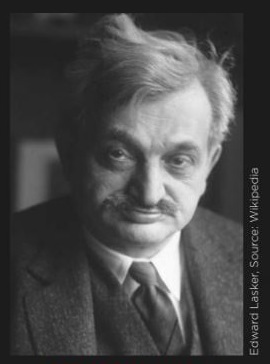
(10538)
On 5 September 2017 Mr Urcan informed us that page 565 of the September 2017 BCM had this ‘Correction’:
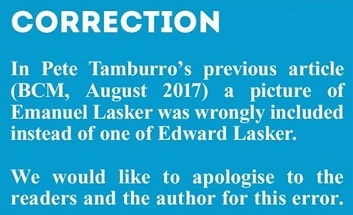
The BCM thus offered not one word of apology for anything other than the Lasker mix-up.
Pete Tamburro (Morristown, NJ, USA) now informs us that, in any case, the correction itself is wrong. His sole contribution to the August 2017 BCM was a separate article on Yates elsewhere in the magazine (‘F.D. Yates and the 5 Bd2 Winawer’, on pages 494-497). The offending article ‘Did F.D. Yates Kill Himself?’ had nothing to do with him.
(10579)
Page 614 of the October 2017 BCM has the following:
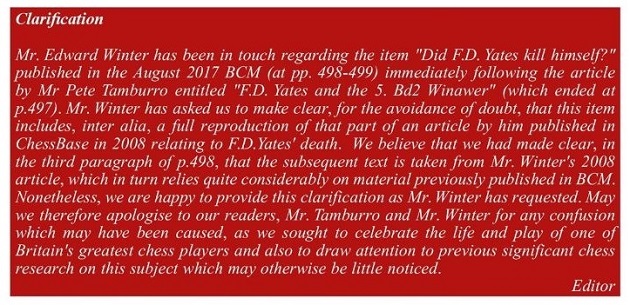
We were ‘in touch’ with the BCM in the sense that on 29 September 2017 we responded to a message (nearly 600 words) received the previous day from Mr Milan Dinic of the BCM. His main defence was that the Yates article in the August 2017 BCM had faulty typesetting (misuse of quotation marks), an argument not only absent from the October 2017 ‘Clarification’ but also in direct contradiction with the magazine’s assertion therein beginning ‘We believe that we had made clear ...’
Our e-mail reply of 29 September 2017:
Dear Mr Dinic,
Thank you for your e-mail message of 28 September 2017 regarding the unsigned article ‘Did F.D. Yates Kill Himself?’ on pages 498-499 of the August 2017 BCM. Please ensure that your apology in the magazine presents the following points:
1. Apart from an introductory overview of Yates’ career which the BCM lifted from Wikipedia, the entire BCM article was copied, word for word, from my feature on Yates at ChessBase in 2008. It should be stressed that that complete feature of mine was reproduced. (Please do not mislead your readers by claiming, as your e-mail message does, that you ‘took under a third of the full [ChessBase] article’; that is only because the rest of my ChessBase article consisted of other features which were nothing to do with Yates.)
2. Even without any BCM typesetting mistakes (concerning quotation marks) of the kind that you indicate, the BCM was obviously not entitled to reproduce an entire feature of mine (approximately 700 words). No fewer than 93 lines of the BCM article were written by me, i.e. about 80% of the text in the two-page BCM article.
3. In acknowledgement of its misappropriation of my work, I ask the BCM to make a substantial donation to charity, and I propose Dimbleby Cancer Care.
Thank you in advance.
Yours sincerely,
Edward Winter
No reply has been received.
(10613)
Below is a letter which we sent on 17 October 2017 by e-mail and registered post to the Editor of the BCM, with a copy to Mr Milan Dinic:
For publication, please
Dear Sirs,
The “clarification” on page 614 of the October 2017 BCM refers misleadingly to my e-mail reply of 29 September to Mr Dinic. As shown by my full text (C.N. 10613 at chesshistory.com), the unsigned F.D. Yates article on pages 498-499 of the August 2017 BCM reproduced, word for word and without permission, an entire ChessBase feature of mine (about 700 words). No fewer than 93 lines of the two-page BCM article were written by me, i.e. about 80% of the whole BCM text.
My e-mail message nominated a charity to which I asked the BCM to make a substantial donation for misappropriating my work.
Yours faithfully,
Edward Winter
No reply, whether public or private, having been received, we simply summarize the facts (as shown in detail in C.N.s 10538, 10579 and 10613):
(10644)
Concerning Yates’ loss to Capablanca in a long game at New York, 1924, see C.N.s 547, 916 and 2138 in José Raúl Capablanca Miscellanea.
For a caricature of Yates by Leopold Löwy see C.N. 11511.
A quote from W. Winter’s Introduction and Biography on page 14 of One-Hundred-and-One of My Best Games of Chess by F.D. Yates:
‘Yates himself was not without certain heterodox opinions, one of which was a decided partiality for doubled pawns. “I have two doubled pawns, I must win”, was a common saying of his, and certainly he secured some surprising victories through the extra mobility which the breaking up of the pawn skeleton gives to the rooks.’
Has this taste been shared by other masters?
(1241)
What is the earliest known sighting of the well-known story about Capablanca turning up in his tennis gear to resume a game of chess against Yates at Hastings? See, for instance, pages 16-17 of The Bright Side of Chess by I. Chernev (Philadelphia, 1948).
We open the bidding with the following ‘once’ version by G. Koltanowski on page 180 of CHESS, 14 January 1936:
‘Capablanca once turned up to play off an adjourned game against Yates, dressed in white flannels and with a tennis racquet in his hand. Didn’t we chuckle when, four hours later, with the darkness of night outside the congress room, he was still playing – chess, not tennis.’
Koltanowski wrote similarly on page 80 of With the Chess Masters (San Francisco, 1972), but on page 24 of Chessnicdotes II (Coraopolis, 1981) he underscored once again his worthlessness as a chronicler by stating that the episode had occurred ‘in the 1929 tournament at Hastings’ in a game between Capablanca and Vera Menchik.
(4114)
Now an earlier (and, again, different) version by Koltanowski can be presented, from page 122 of the 1 December 1932 issue of his magazine Chess World:
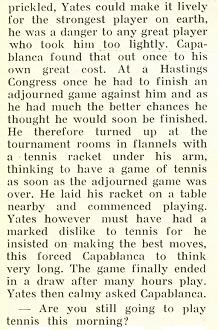
His account in CHESS spoke of ‘the darkness of night’, but now there is a reference to playing tennis ‘this morning’. More substantively, Capablanca and Yates had only one draw in any Hastings tournament, on 4 January 1930. Koltanowski was there, playing in the Premier Reserves event, but since the Cuban’s game against Yates was not adjourned (it lasted only 26 moves), the confusion continues.
(5549)
Yet another version of Koltanowski’s anecdote, from page 19 of his book Torneo internacional de Hastings 1935-1936 (Barcelona, 1936):

(7876)
An endnote on page 264 of Chess Explorations:
Commentators remarked on Nigel Short’s willingness to accept doubled pawns in his 1993 match against Kasparov.
A photograph of F.D. Yates and C. Schlechter at Hamburg, 1910 has been supplied by Jan Kalendovský (Brno, Czech Republic), courtesy of Zdenĕk Závodný:
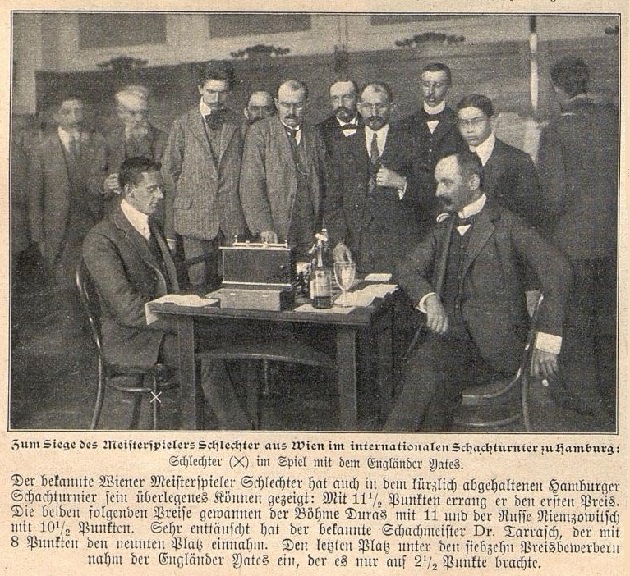
Source: Deutsche Frauen- und Modezeitung, 22/1910, page 12.
(11338)
C.N. 7910 drew attention to a surprising article by Stephen John Mann on the Yorkshire Chess History website which advocated, on the basis of extensive documentation, ‘Fred Dewhirst Yates’:
‘The popular rendering of his name as “Frederick Dewhurst Yates” is erroneous. There seems no evidence of any formal, official documents ever calling him “Frederick”; instead “Fred” seems to appear throughout. “Dewhurst” is a spelling mistake now widely copied in the literature.’
Given that, in the seven years since C.N. 7910 carried that item on Yates, no historian has, to our knowledge, disputed Mr Mann’s conclusion, it would seem appropriate for efforts to be stepped up to eradicate occurrences of the previously-accepted version, ‘Frederick Dewhurst Yates’.
(11545)
We wonder when the now-discredited form ‘Frederick Dewhurst Yates’ first appeared in print, i.e. what antedates the obituary by P.W. Sergeant on pages 525-528 of the December 1932 BCM, which had two occurrences on the first page:
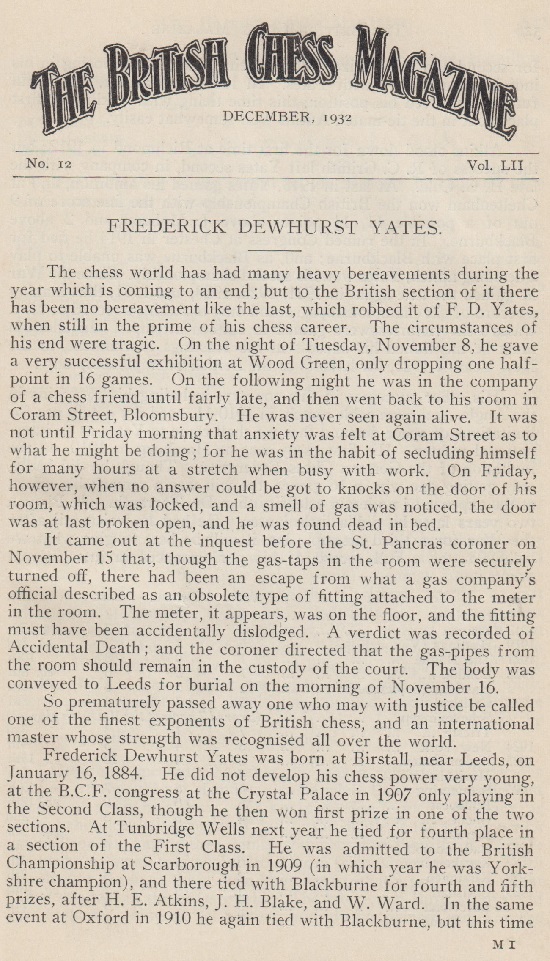
See too the heading of a letter from W.H. Watts on page 529:
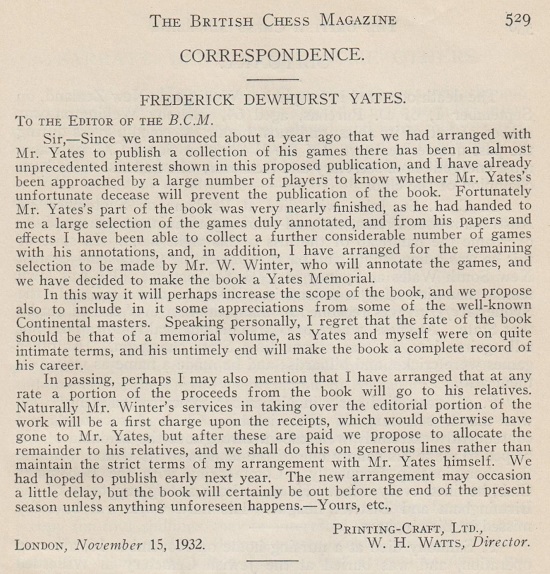
From Over and Out:
Purely by way of example, we examine here one particular untruth by K. Whyld in his review of Kings, Commoners and Knaves in the May 1999 BCM, a piece which was accompanied (on page 271) by a photograph with this caption:
‘William Winter – did Edward Winter perhaps confuse his namesake with Yates?’
The photograph was there to illustrate, and reinforce, the following attack by K. Whyld on a KCK item:
‘On page 181 he [E.W.] notes that B.H. Wood wrote “Yates died a sloven, a drunkard, in pathetic circumstances” and Winter adds “A mix-up with William Winter?” Tremendous. Two slurs for the price of one, and a bloody nose for Wood, who at least knew what he was talking about.’
Whyld then added with a further sneer: ‘They’re all dead anyway, so let’s publish.’
Let us return to the facts. On page 59 of J. Giżycki’s A History of Chess B.H. Wood wrote, ‘Yates died a sloven, a drunkard, in pathetic circumstances’. A C.N. item from 1987 which was reproduced on page 181 of KCK quoted those words of Wood’s, and we added a five-word comment of our own: ‘A mix-up with William Winter?’ The reason for this query is self-evident: the lack of such claims about Yates, coupled with the abundance of them (strongly and openly expressed) concerning William Winter. For example, the obituary in CHESS, Wood’s own magazine (24 December 1955 issue, page 101), stated that although W.W. was occasionally well-groomed he ‘might turn up at a chess match or a meeting in a state of almost indescribable filth – clothing and person alike’. Another figure well acquainted with W.W. was Harry Golombek, who wrote on page 343 of his 1977 Encyclopedia that away from the board W.W. was ‘more often than not, drunk’.
Moreover, a reader of CHESS, J.Y. Bell, discussed both F.D. Yates and W. Winter on page 212 of the 20 April 1963 issue:
‘Yates, who seems to me to have been at least as hard up as Winter, managed to present a decent appearance in public.’
To this, the Editor (i.e. B.H. Wood, the man ‘who at least knew what he was talking about’) added immediately afterwards:
‘Yes, Winter often presented a most filthy and disreputable appearance.’
That is the public record. We have not originated a single slur, let alone two. We have not given B.H. Wood ‘a bloody nose’. We merely asked a legitimate five-word question about the possibility of a mix-up over W. Winter and F.D. Yates. Remarkably, though characteristically, Whyld twisted that question into a ‘claim that Wood was wrong’.
We add the following exchanges in C.N. 1438 (after our five-word comment in C.N. 1422, ‘A mix-up with William Winter?’):
From K. Whyld:
‘I believe you are wrong in thinking there has been a mix-up. Winter died of tuberculosis in London University Hospital. Yates died from a gas leak. Both were drinkers, and both casual, at least, in their appearance. I should make it clear that I never met Yates, and speak of him by hearsay only.’
Apart from B.H. Wood’s quoted paragraph, we have never see any suggestion in print that Yates was ‘a sloven, a drunkard’, whereas these epithets have frequently been applied to William Winter.
There the matter stood until, some 11 years later, Kenneth Whyld attacked us in the BCM, as quoted above.
A group photograph from London, 1927:

Seated from left to right: F.J.
Marshall, W. Winter, E. Bogoljubow, A. Nimzowitsch, W.A.
Fairhurst, S. Tartakower.
Standing: W.H. Watts, M.E. Goldstein, H. Kmoch, M. Vidmar, R.C.
Griffith, Sir George Thomas, E. Busvine, F.D. Yates, J. Schumer,
E. Colle, V. Buerger, R. Réti
(3959)
Addition on 25 January 2024:
From Alexander Alekhine Miscellanea:
Olimpiu G. Urcan contributes, from the studio archives of the Italian photographer Oscar Vianello, a number of shots taken in San Remo in 1930. Below are two pictures of Alekhine’s game against Yates:
On page 6 of the Liverpool Post & Mercury, 14 November 1932 Gerald Abrahams paid tribute to F.D. Yates:

From page 6 of the following day’s newspaper:

Yates’s loss to Sir George Thomas in Canterbury (1930) has been widely published. For a group photograph of participants in the tournament, see C.N. 4350.
(12139)
To the Chess Notes main page.
To the Archives for other feature articles.
Copyright: Edward Winter. All rights reserved.